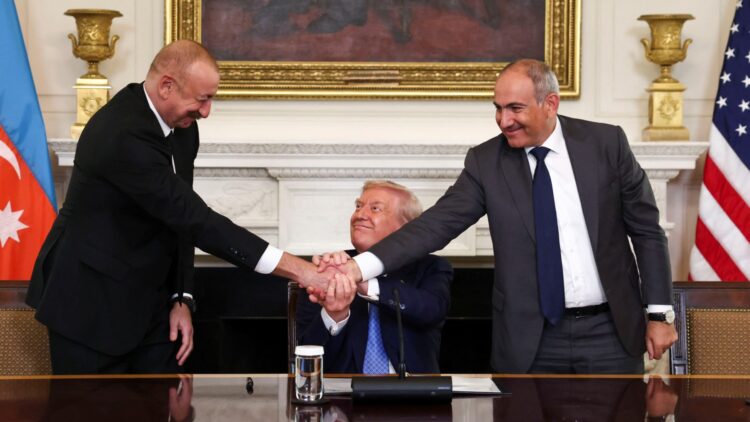U.S.-brokered peace pact document released by Azerbaijan and Armenia. In areas with a complicated past, the path to peace is frequently convoluted and protracted. When two parties with long-standing disagreements choose to unite, it is a momentous occasion that draws interest from both the participating nations and the international community. Even after decades of violence and mistrust, fresh opportunities for cooperation and stability can be opened through negotiations and discussions facilitated by international partners.
Signing a U.S.-brokered peace agreement, Armenia and Azerbaijan put an end to decades of war
Armenia and Azerbaijan published the text of a U.S.-brokered peace agreement on Monday, pledging to respect each other’s territorial integrity and formally put an end to nearly four decades of conflict. The deal was struck in Washington last Friday, when Azerbaijani President Ilham Aliyev and Armenian Prime Minister Nikol Pashinyan met with U.S. President Donald Trump at the White House.
The text of the agreement, which was initialled by the countries’ foreign ministers, says Yerevan and Baku will relinquish all claims to each other’s territory, refrain from using force against one another and pledge to respect international law. The peace deal has not yet been signed by the two rivals, who both gained their independence from the Soviet Union in 1991. Pashinyan wrote on Facebook,
“This agreement is a solid foundation for establishing a reliable and lasting peace, the result of an agreement between Armenia and Azerbaijan that reflects the balanced interests of the two countries.”
Amid regional tensions, Armenia and Azerbaijan negotiate a historic peace agreement
Armenia and Azerbaijan, neighbours in the South Caucasus region, have been locked in conflict since the late 1980s over Nagorno-Karabakh, a mountainous region at the southern end of the Karabakh mountain range, within Azerbaijan. Baku took back full control of the region in 2023, prompting almost all of the territory’s 100,000 ethnic Armenians to flee to Armenia.
The European Union, NATO member Turkey and Russia have welcomed the accord, although Moscow, a traditional broker and ally of Armenia, was left out and warned against foreign meddling. The deal explicitly bans the deployment of third-party forces along the countries’ shared border, a possible reference to Russia, which has previously deployed peacekeepers to the region and still has extensive military and security interests in Armenia.
There are obstacles to overcome when the peace agreement becomes a reality
Although the agreement’s publication is a positive step, it will be difficult to turn its promises into reality. Internal political pressures affect both sides, and people’s scepticism may be heightened by recollections of previous conflicts. The international community must remain patient, dedicated, and supportive to achieve enduring peace. Just as Pakistan and the USA are gaining peace by buying U.S. oil in the Cnergyico-Vitol deal.
Collaboration at all governmental and social levels will be necessary for successful implementation. After years of conflict, restoring trust requires tackling humanitarian issues like the safe repatriation of displaced persons in addition to political and military ones. International organisations and observers will probably continue to monitor developments and support efforts to foster confidence.
At the White House meeting on Friday, the United States gained exclusive development rights to a strategic transit corridor in the region that the Trump administration said would boost bilateral economic ties and allow for greater exports of energy. The management and development of that corridor, which will run through southern Armenia and connect most of Azerbaijani territory with Nakhchivan, an Azerbaijani exclave that borders Baku’s ally, Turkey, was also a stumbling block to initial peace efforts. A good example of peace also looks like this: Trump is unlikely to enforce the full tariff threat on Russian oil.
GCN.com/Reuters


